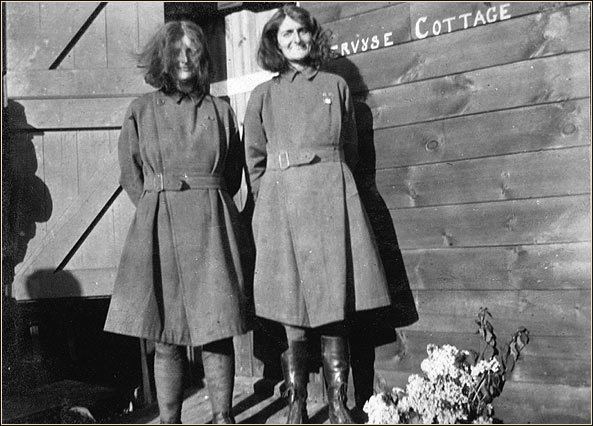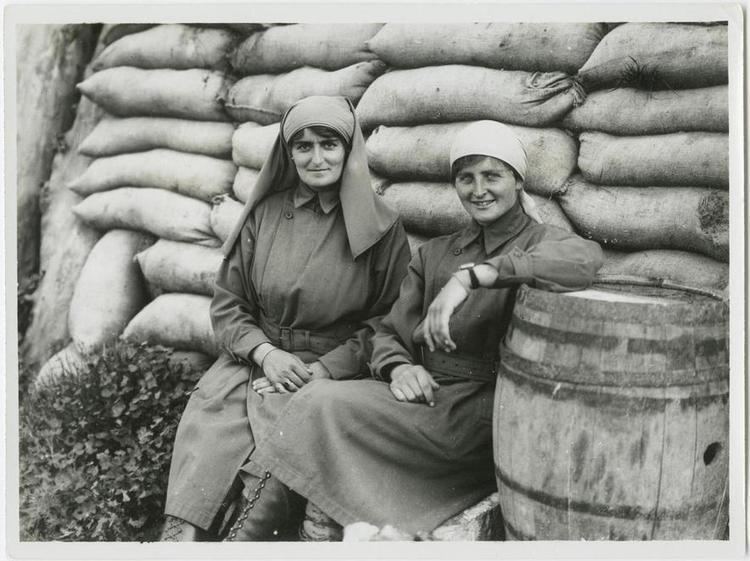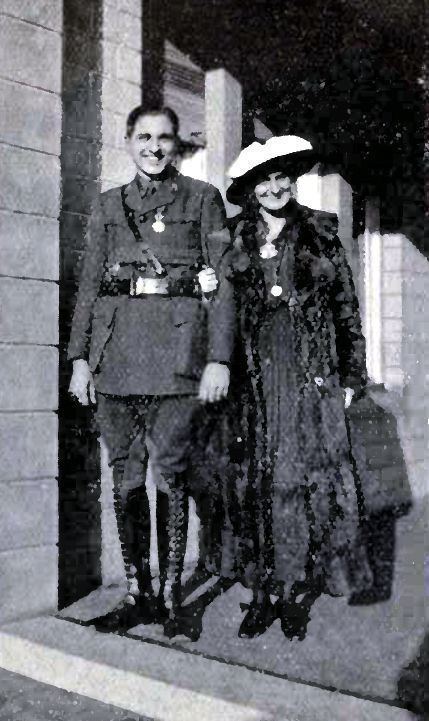Profession Nurse Role Nurse | Name Elsie Knocker | |
 | ||
Education St. Nicholas's, FolkestoneChateau Lutry, Switzerland Years active September 1914 - March 1918 Institutions Children's Hip Hospital, SevenoaksQueen Charlotte's HospitalMunro Ambulance Corps Institution Queen Charlotte's and Chelsea Hospital | ||
Elsie knocker at mary swanwick school
Elsie Knocker, MM, OStJ (29 July 1884 – 26 April 1978) was a British nurse and ambulance driver in World War I who, together with her friend Mairi Chisholm, won numerous medals for bravery and for saving the lives of thousands of soldiers on the Western Front in Belgium. Dubbed "The Madonnas of Pervyse" by the press, the two became the most photographed women of the war.
Contents
- Elsie knocker at mary swanwick school
- The cellar house of pervyse audiobook mairi chisholm and elsie knocker
- Early life
- Hospital service and first marriage
- World War I
- War service 1914 1915
- Second marriage 1916
- War service 1916 1918
- Inter war period
- World War II
- Later life
- Diaries
- Gallery
- References

The cellar house of pervyse audiobook mairi chisholm and elsie knocker
Early life

She was born Elizabeth Blackall Shapter in Exeter, Devon on 29 June 1884, the youngest of five children to Dr. Thomas Lewis and Charlotte Shapter (nee Bayly). During her childhood she picked up the nickname, "Elsie". She was orphaned at an early age. Her mother died when she was four years old and her father died from tuberculosis two years later. She was subsequently adopted by Lewis Edward Upcott, a teacher at Marlborough College, and his wife Emily who sent her to be educated at St. Nicholas's, Folkestone, and then at the exclusive Chateau Lutry in Switzerland.
Hospital service and first marriage

After training at the Children's Hip Hospital at Sevenoaks, she married Leslie Duke Knocker in 1906, with whom she had a son, Kenneth Duke, a year later. But the marriage failed and soon after she was divorced she began training as a midwife at Queen Charlotte's Hospital. Since being divorced was a status frowned upon in Edwardian England, Knocker invented the myth that her husband had died in Java, leaving her a widow.

Being a divorcee/widow and single mother, however, hardly kept Knocker away from her passions. She became an ardent amateur motorbike enthusiast and when riding wore a dark green leather skirt and long leather coat buttoned all the way down with a belt "to keep it all together" designed by Dunhill. She earned the name "Gypsy" because of her love of the open road and membership of the Gypsy Motorcycle Club. She possessed a number of motorbikes including a Scott, a Douglas solo, and a Chater-Lea with a sidecar which would travel with her to the Western Front.
World War I
When war was declared in 1914, Knocker wrote to her friend and fellow motorcycle fanatic, Mairi Chisholm, that there was "work to be done", and suggested they go to London to become dispatch riders for the Women's Emergency Corps. When Chisholm was chosen to join Hector Munro’s Flying Ambulance Corps she was able to convince Munro to accept Knocker as well seeing as she had some training as a nurse, was an excellent mechanic and chauffeur, and spoke both French and German. This meant that Knocker had to cancel a "ladies stiff reliability trial" with "plenty of hairpin bends" over 120 miles of Hampshire and Dorset countryside. The day before she was due to ship out she wrote in her diary:
"This time tomorrow night I shall be in Belgium… in the midst of all the terrors of war."
War service, 1914-1915
In the early evening of 25 September 1914, Knocker, Chisholm and the other volunteers (which included Dorothie Feilding and May Sinclair) followed Dr. Munro down the gang-plank of the S.S. Princess Clementine at Ostend, West Flanders. Whilst visiting the town of Nazareth (8 miles south-west of Ghent where the corps was initially quartered) Knocker was witness to the aftermath of a massacre when she came across 26 Belgian military policemen who had been shot and mutilated by the Germans. At the end of October, the corps relocated to Furnesin unoccupied Belgium, near Dunkirk, where the women worked tirelessly picking up wounded soldiers mid-way from the front and bringing them back to their field hospital at the rear. Knocker and Chisholm soon came to the conclusion that they could save more lives by treating the wounded directly on the front lines.
In November, the two decided to leave the corps and set up their own dressing station five miles east in a town named Pervyse, north of Ypres, just one hundred yards from the trenches. Here, in a vacant cellar which they named the "Poste de Secours Anglais" ("British First Aid Post"), the two would spend the next three and a half years aiding the wounded in the Belgian sector. Knocker gave most of the medical attention, while Chisholm transported the injured, often in terrible conditions and under fire, to a base hospital 15 miles away. No longer affiliated with the Belgian Red Cross, they were forced to raise their own funds. With donations they arranged for the cellar to be reinforced with concrete and even have a steel door fitted, supplied by Harrods. Through sheer perseverance Knocker was able to arrange for the two of them to be officially seconded to the Belgian garrison stationed there. Equipped with cameras, both women photographed not only each other but also much of the suffering around them. In January 1915, they were rewarded for their courageous work on the front lines when they were both decorated by King Albert I of Belgium with the Order of Leopold II, Knights Cross (with palm).
Second marriage, 1916
In January 1916, Knocker married again, this time to a pilot in Belgian Flying Corps who happened to be a baron, named Harold de T'Serclaes. The newly formed Baroness wrote of her marriage:
“So much of me went into my work that I suppose I was easily swept along on a tide of glamour and welcome frivolity. Perhaps I had a desire just to drift for once, not to struggle. It was pleasant to imagine that all would turn out well, and after fifteen months' risking my life at the Front marriage seemed a comparatively small risk to take. I did want someone to take some of the burden off my shoulders and thought how good it would be for Kenneth to have a father. After a lightening honeymoon we hardly saw one another again. I was too busy at Pervyse, and my husband had to return to his squadron.”
War service, 1916-1918
Knocker and Chisholm engaged in multiple battlefield rescues, even carrying fallen men on their backs to their first-aid station. After she and Chisholm rescued a wounded German pilot in No Man's Land both women were awarded the British Military Medal, and made Officers, Most Venerable Order of the Hospital of St. John of Jerusalem. Fellow corps volunteer May Sinclair said of Knocker: "She had an irresistible inclination towards the greatest possible danger."
As word spread of their deeds they began to get visits from journalists, photographers and VIP's earning them the subsequent distinction of being the most photographed women of the war. The war ended for both women in March 1918, when they were gassed during a German offensive and had to return home.
Inter-war period
By 1919, Knocker's marriage to the Baron had unraveled when both he and the Roman Catholic Church discovered the truth about her previous marriage. For Chisholm, this deception ended their friendship. The two barely spoke again. As part of the settlement Knocker was allowed to remain a Baroness in name only.
World War II
In 1939, at the outbreak of World War II, the Baroness joined up again and became a senior officer in the Women's Auxiliary Air Force (WAAF) working with RAF Fighter Command and was twice Mentioned in Despatches. Tragedy struck on 3 July 1942 with the death of her son, Wing Commander Kenneth Duke Knocker, who was killed when his plane was shot down over Groningen.
She left the RAF in 1942 following her son's death and because she needed to look after her elderly foster-father.
Later life
After the Second World War the Baroness participated in raising funds for the RAF Association and the Benevolent Fund. She lived in the Earl Haig Homes in Park Lane, Ashtead, Surrey from approximately 1926 until her death. Later in life she began breeding Chihuahuas and was always accompanied by three or four of them. She was greatly concerned about the welfare of both animals and the conservation of Ashtead Common where she could often be seen walking her pets, "flamboyantly dressed with large earrings and a voluminous dark cloak". On 26 April 1978 the Baroness died aged 93 of pneumonia and senile dementia. She had never remarried.
Diaries
The Imperial War Museum holds Knocker's diaries along with recordings and transcripts of interviews.
